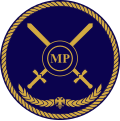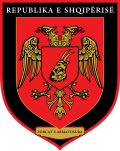History
After the fall of the 50-year-long communist regime of Albania, there was a need to reform the Armed Forces in all its pertinent structures. On 1 February 1992, the Military Police was established upon approval by Parliament of Law No. 511, dated 08.08.1991, "On the Military Police in the Armed Forces of the Republic of Albania". The purpose of this structure was to strengthen order and discipline in AAF and it was considered as an essential thing to transform the Army according to NATO countries’ standards.
With the creation of MP, the focus of its work was to control military vehicle traffic, maintenance of military rule in order to strengthen discipline in AF. In December 1994, attached to MP, were created the structures of Criminal Police and Fire Fighting Service. In early 1995, the MP branch in General Staff was transformed into the MP directorate commanded by Brig. Gen. Bajram Malaj. Through legal support, regulations and its professionalism growing day by day, the MP ranked among the best units of the Armed Forces.
After the events of 1997, the MP Director was Col. Piro Lutaj. After the events of 1997, MP had a tremendous growth on the basis of a project with the Italian Delegation of Experts (DIE). At that time, with the assistance of Italian specialists, for the first time, the MP battalion was created in Tirana, which was equipped with the necessary logistics and materials, and it was conceived according to Italian Carabinieri battalions. The establishment of MP battalion in Tirana marks a qualitative leap in the activity of this modern structure and the most qualitative of the time, which became apparent in the events of 1998, when the MP not only suffered any damage, but it defended several state institutions such as, the Radio Televizioni Shqiptar, Albtelecom, General Prosecutor's Office and several international institutions.
Equipment of MP battalion in Tirana, with the necessary technique and armoured vehicles Iveco VM 90, played a huge role in the events of 1998 in Albania. This structure played an undeniable role in 1999, during the Kosovo crisis, when it had the major role for the welcome, escorting and treatment of refugees at camps set up in Kukës, Tirana, Durrës and other cities around the country, keeping under control the situation in the areas of Kukës, Krumë, Tropojë, especially at border posts, solving many difficult situations, escorting convoys and personalities that travelled to north and back, as well as maintaining control of the road network across the country, especially in the north. The events of 1997, 1998 and the Kosovo crisis are the most important events in the history of MP. [4]
In late 2000, with the suppression of the structure of the MP Directorate, by the Order of the Ministry of Defence no. 1, dated 01.05.2001, “On the organization of the Military Police Regiment”, the Military Police Regiment was established and its commander was Lieutenant colonel Namik Goga. This structure exercised its activity until September 2003, protecting and safeguarding all exercises that took place on the territory of the country. In September 2003, the MP structure was transformed into a battalion structure based in Tirana and its commander was Lieutenant colonel Xhevahir Avdia, who held this office until 2005. In 2005 the commander of the battalion was appointed Lieutenant colonel Drini Nikolla, who held this office until 2008.
In July 2007, the MP battalion became an organic part of the Support Command, and its administrative management was subordinated to the Support Command, while its Operational Commanding was subordinated to the General Staff. Part of the battalion were four sections of MP in Shkodër, Durrës, Berat, Vlorë and five subsections of MP, in Kukës, Burrel, Elbasan, Korcë and Gjirokastër, where the sectors of Criminal Police, Judicial Police, vehicle traffic, Fire Fighting and Rescue conducted their activities.
In 2008, Colonel Xhevdet Zeneli became commander of the MP battalion. In May 2010, the structure of the Military Police was named Military Police of the Armed Forces in compliance with Law No. 9069 dated 15.05.2003, “On the Military Police of the Armed Forces", and MP continues to have this structure nowadays. [5] [6] [7]
During these years, MP is trained by the specialists of Italian Carabineers, U.S., German and Turkish military police.
For years, MP, through a special program, is preparing a sub-unit of platoon-level NRF (NATO Response Force), a force ready to act as part of NATO relevant structure, capable and suitably equipped to perform such duties.
So far, around 50 people of Military Police have been part of different missions abroad, in Iraq and Afghanistan, in support of the Armed Forces and various international HQs. MP has also conducted a mission in “ISAF” military operation, in Kabul, Afghanistan. This platoon consisted of 22 people.








